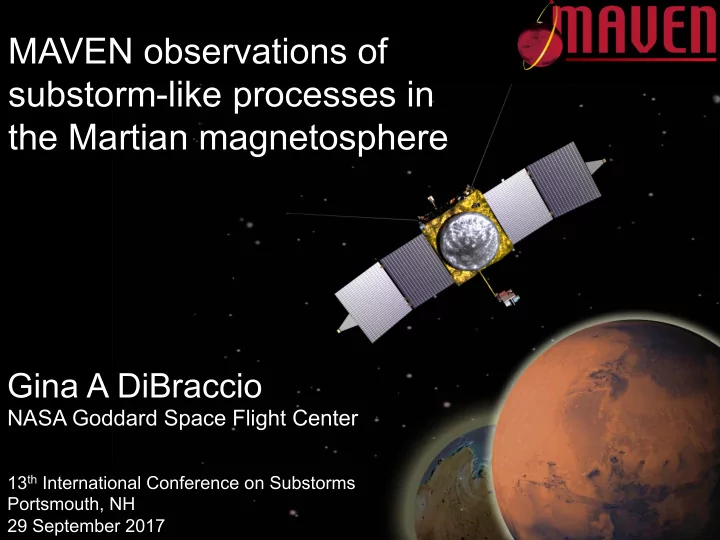

MAVEN observations of substorm-like processes in the Martian magnetosphere Gina A DiBraccio NASA Goddard Space Flight Center 13 th International Conference on Substorms Portsmouth, NH 29 September 2017
Mars’ Magnetic Environment • No global intrinsic field Connerney et al., PNAS , 2005 • Localized crustal magnetic fields • Strongest sources at 180°E Longitude in southern hemisphere Gina.A.DiBraccio@nasa.gov 2
Martian Magnetosphere • Induced magnetosphere with localized planetary fields • IMF direction influences the field structure • Similar regions to intrinsic magnetospheres with similar processes on different scales Brain et al. [2015] • No ‘Dungey Cycle’ Gina.A.DiBraccio@nasa.gov 3
MAVEN’s Orbit Orbit precesses to provide complete coverage View from tail Side View Gina.A.DiBraccio@nasa.gov 4
Magnetic Reconnection at Mars Halekas et al. [2009] Gina.A.DiBraccio@nasa.gov 5
Tail Reconnection: Fast Flows • Particle acceleration in the tail current sheet • Downtail speeds of 100 km/s or greater DiBraccio et al. [2015] Gina.A.DiBraccio@nasa.gov 6
Tail Reconnection: Flux Ropes Current sheet crossing with embedded flux rope supports magnetic reconnection DiBraccio et al. [2015] Gina.A.DiBraccio@nasa.gov 7
Tail Reconnection: Flux Rope Chains MGS - Eastwood et al. [2012] MAVEN - Hara et al. [2017] Gina.A.DiBraccio@nasa.gov 8
Tail Reconnection: Hall Fields N (a) 20 |B| 10 Bz B MSO [nT] 0 By -10 Bx -20 L (b) |B-Bc| 1.0 M /|B| 0.5 0.0 #3 (c) 1 b 1 . b 2 Hall B polarity => 0 Crossing sunward -1 (d) cs of the X line (e) 20 λ L / λ M = 18.73 B N λ M / λ N = 6.79 10 B LMN [nT] B M L = [ 0.99, 0.15, 0.08] 0 M = [-0.17, 0.76, 0.63] B L N = [ 0.04,-0.63, 0.77] -10 (f) 10 8 1000 1000 10 7 Energy Eflux [eV] 10 6 e - 100 100 S/C 10 5 10 10 10 4 trapped e - (g) 10 6 180 180 [deg.] Eflux P.A. 10 5 e - 90 90 10 4 0 0 (h) 10 8 B M 10 4 10 4 10 7 Energy 10 3 10 3 [eV/q] Eflux Ion 10 2 10 2 10 6 B N 10 1 10 1 10 5 10 0 10 0 Sunward flow 10 -1 10 -1 10 4 (i) enhancement 20 + B L O 2 15 [km/s] 10 O + V L 5 #3 0 H + -5 -10 (j) 4 + O 2 2 [km/s] O + S/C V N 0 H + -2 V L -4 Alt. [km] 2449.6 2291.8 2132.3 1971.6 1810.3 SZA [deg.] 156.8 159.8 162.8 165.9 169.1 hhmm 1914 1916 1918 1920 1922 2014 Nov 30 Harada et al. [2017] Gina.A.DiBraccio@nasa.gov 9
Energy-time Dispersed Electrons Impulsive injections of electrons onto closed crustal fields • Falling tones from ~200 eV to ~50 eV • Electrons PADs show two-sided loss cones Harada et al. [2016] Gina.A.DiBraccio@nasa.gov 10
Tail Loading and Unloading Loading • Occurs over intervals of 3-5 min • IMF drapes over planet and flux builds Unloading • Occurs over intervals of 2-4 min • Sudden |B| decrease by factor of 6 • Flux ropes support reconnection DiBraccio et al. [2015] Gina.A.DiBraccio@nasa.gov 11
Aurora Image credit: M. Holstrom/ESA Schneider et al. [2015] Gina.A.DiBraccio@nasa.gov 12
Discrete Aurora MEX/SPICAM aurora detection: • Confined increase in UV brightness • Emission from vertical crustal field or ‘cusp’ region • ~130 km altitude Bertaux et al . [2005] MGS observations: • Peaked electron distributions • 400 km altitude on nightside • Correlated with strong crustal fields Brain et al . [2006] Gina.A.DiBraccio@nasa.gov 13
Diffuse Aurora MAVEN observations: • Rise in auroral brightness correlated with SEP arrival • 60-100 km altitude • Coverage obtained over subsequent orbits • 5 day period Schneider et al . [2015] Gina.A.DiBraccio@nasa.gov 14
Effects of Solar Storms Earlier flare and SEPs Second flare and SEPs EUV irradiance SEP energy SWIA Energy Btot • Three solar events occurred on March 1st, 6th, and 8 th 2015 • Global magnetosphere disruption Jakosky et al., Science, 2015 Gina.A.DiBraccio@nasa.gov 15
Summary • Mars experiences substorm-like signatures: – Magnetic reconnection (hall fields, fast flows, etc.) – Flux rope formation – Tail Loading/Unloading – Aurora – Energy-time dispersed electrons – Global response to solar events – FACs – Inverted-Vs • A global process has yet to be quantified – Does one exist? – It is possible to find a single definition of a Mars storm? Gina.A.DiBraccio@nasa.gov 16
Recommend
More recommend